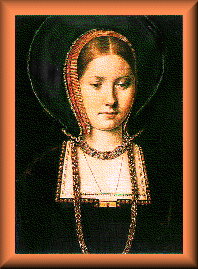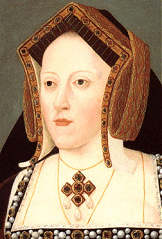CATHARINE OF ARAGON
![]()

BORN: 16 DECEMBER 1485
MARRIED: 11 JUNE 1509
DIVORCED: 1533
DIED: 7 JANUARY 1536
![]()
CATHARINE OF ARAGON
![]()

BORN: 16 DECEMBER 1485
MARRIED: 11 JUNE 1509
DIVORCED: 1533
DIED: 7 JANUARY 1536
![]()
Catalina of Aragon was born in Alcalᠤe Henares, Spain. She was to become the first wife of Henry VIII. The daughter of Ferdinand and Isabella of Spain, she was brought to England in 1501 to be the bride of Henry's older brother, Arthur, then the Prince of Wales and heir to the throne. Catharine, as she was called by the English, and Arthur were married on 14 November 1501 in Old St. Paul's Cathedral, London, but the union was short lived--within a few months, Arthur had died of a "consumption" or wasting illness in 1502, and the young Princess of Wales was a widow--at the age of sixteen.
Catharine was left in an extremely uncomfortable position in England. Having been married, she was now of dubious value on the marriage market of Europe, and her father, Ferdinand, was reluctant to have her return home. Henry VII, felt that Catharine, now Dowager Princess of Wales, was not his responsibility, so he did little to provide for her needs in his court. She was put in insignificant quarters, her household of servants from Spain was reduced to a bare minimum, and she was frequently reduced to selling bits and pieces of her dowry plate to provide herself and her servants with bare necessities.
A plethora of plans were devised to dispose of Catharine honorably--Ferdinand proposed that she should be married to young Henry, now Prince of Wales, and the suggestion was also made that she become the bride of the newly widowed Henry VII,who was himself stricken with tuberculosis, and old enough to be her grandfather. Eventually, she was betrothed to young Henry, who was twelve years old at the time. A year later, he "secretly" rescinded his vows of betrothal, probably under pressure from his father, who was actively courting the favor of France, and wished to betroth his only eligible son to a French Princess. Catharine was also at one point appointed Ambassador from Spain by her father, who was in financial straits, and unable to pay an Ambassador. Catherine's teen years and early twenties passed in a condition of genteel but extreme poverty, in a tenuous and often nebulous position in the English court.
Catharine had finally been recalled to Spain and was actively readying to make the journey there when Henry VII died in 1509. The new king, Henry VIII, went to her immediately and proposed--he was eighteen, she was twenty-four. She had no money, position or dowry, and at that moment in time, Henry VIII was the most eligible bachelor in Christendom-- young, handsome and incredibly rich, as his father had spent his entire reign parsimoniously amassing an enormous Treasury that his son promptly began to spend as grandly and rapidly as he could. There was no need for a political alliance to Spain through marriage--Henry's political position would have been better served by a marriage to a French princess. There was no practical reason for him to marry Catharine.
Henry and Catharine were crowned in a joint coronation ceremony on June 24, 1509.
All records point to the marriage having been a love match, and the young couple were astonishingly well suited. Catharine was very well educated for a woman of her day, and like Henry, had a lively interest in learning, music and the arts. She and Henry set out to make the English court a center of learning and culture, attracting artists and scholars to England. Henry had flung aside the medieval gloom of the court of Henry VII, and modernized many of the royal residences, procuring furniture and art objects from the continent, and making masques, dances and other cultural entertainments regular fare at the English court.
Catharine became pregnant early in the marriage, and delivered a stillborn daughter prematurely in January, 1510. On January 1, 1511 Catharine delivered a healthy, full-term son. Henry ordered great celebrations for the birth of his heir. Unfortunately, this child, slated to be Henry IX, died after 52 days. A number of miscarriages and stillbirths followed, until Princess Mary was born in February, 1516 and survived infancy and early childhood. Catharine continued to become pregnant, but no other infants survived more than a few hours after birth. Her final child, a girl, was born deformed and dead, planting the seed in Henry's mind that their marriage was somehow cursed.

By the time Catharine had reached the end of her childbearing years, she was well into middle age. Endless pregnancy and repeated childbirth had destroyed what was once documented to be a beautiful figure, and she was aged long before her time. The Madonna-like, golden haired princess of the portrait above had become a heavy, aged woman who suffered from increasingly severe arthritis and other ailments of the elderly. One onlooker at the diplomatic meeting of the French and English at The Field of the Cloth of Gold remarked that "the King of England is young and handsome, but his wife is old and deformed".
Catharine was more than content to devote the rest of her life to domestic pursuits, her main concern being the education of her daughter, Mary, the Princess of Wales. Catharine's mother, Isabella of Castile, had been a ruling queen in her own right, and Catharine saw no reason why Mary could not rule England successfully. Henry, on the other hand, was dubious about England being ruled by a woman. If she married a foreign prince, England would in essence become a principality of whatever country her husband ruled. Should she marry an Englishman, it would cause dissension among the nobles, possibly leading to civil war. The Wars of the Roses were a recent memory for all Englishman, and no-one relished the idea of more years of war.
As there was no hope of future heirs as far as Catharine was concerned, Henry attempted to have his illegitimate son, Henry Fitzroy, born after a liason with Elizabeth Blount, brought forward, giving him royal titles in hope of having the English accept him as the heir to the throne. But Catharine and Mary were well loved, and it became apparent quickly that the people of England would not tolerate Henry's illegitimate son becoming the Prince of Wales.
Divorce and remarriage were unthinkable in Henry's time, as almost all of Europe was Catholic. Henry himself had refuted Martin Luther's writings, earning himself the honorary title "Defender of the Faith". Queens who were put aside "voluntarily" retired to convents, or an expedient annulment could be procured from Rome--at a price.
Henry had fallen in love with Anne Boleyn, one of Catharine's maids of honor. His marriage to Catharine had been marred by some infidelities, but in Mistress Boleyn, Henry encountered something out of the ordinary--a woman who refused to become the mistress of the King. Anne Boleyn wanted to become Queen, and she was ready to bargain her virtue for that goal. The combination of the unattainable woman and his desire for a son made Henry determined to end his marriage to Catharine. Initially, in 1527, Henry took his case for annulment to Rome without Catharine's knowledge, petitioning the Pope to end his marriage of nearly twenty years on the grounds that Catharine had been the widow of his brother, citing an obscure verse from Leviticus which says that if a man takes his brother's wife, they shall be childless for such a man would have "uncovered his brother's nakedness". Catherine and Henry had one living child. But, that child was a girl, and Henry felt that a King without a male heir was essentially childless.. The King began to petition the Pope for an annulment. Catharine, by being Arthur's wife, became "one flesh" with him--Henry reasoned that by becoming her second husband, he had "uncovered his brother's nakedness" and had brought the curse of childlessness upon their marriage.
The Pope's technique in dealing with "the English King's Great Matter" was to stall, hoping that a number of possibilities would take place: that Catharine would consent to "retire" to a convent, making it possible to anull the marriage without incident; that Henry would lose interest in Anne Boleyn; that Anne Boleyn would give in and become the King's mistress while he retained his marriage to Catharine; or that Catharine would die, making all legal and spiritual wrangling obsolete. The Pope failed to reckon on the strength of the three central personalities in the English King's Great Matter.
Catharine was staunchly determined that her marriage was valid, was insistent that her short-lived marriage to Arthur was never consummated, and that they were therefore not truly husband and wife. This argument nullified Henry's stance that his marriage was cursed because he and Arthur had both been married to the same woman. Catharine was determined to maintain her position as Queen and her daughter, Mary's, claim to the throne at all costs.
Anne Boleyn was equally determined to become England's Queen, and had an almost eerie hold over King Henry, a charisma that would cause her to later be labelled a witch, as her influence over him at this time was so powerful.
Lastly, Henry was determined to have a son to inherit the throne of England, and he was determined that Anne Boleyn would be the Queen who could supply him with that all important male heir.
Initially, Catharine retained the title of Queen of England and continued to stay at Court, though Anne Boleyn had already begun to "reign" as unofficial Queen, appearing with Henry at Court functions and having the Queen's quarters at Court while Catharine was exiled to smaller quarters nearby. But public favor was on the side of Queen Catharine and her daughter, and Henry realized that he must remove her from public view, so that people would begin to forget her and withdraw their support. He initially separated her from Princess Mary, sending their young daughter away with her household to Beaulieu, one of Mary's estates. Catharine remained at Court, but appeared in public less frequently. She frequently begged Henry to allow her to visit Mary, and he consented, by telling her she could go alone. Catharine knew this was a ploy to make it appear as if she was abandoning the marriage, and steadfastly remained at Court, ignoring snubs and outright cruelty meted down to her on the part of her husband and his mistress.
Where Henry had waited for Catharine to make the error of leaving him, he now left her alone at Greenwich, while he rode away on a hunting trip with Anne Boleyn. He left orders for her to retire to her manor at Kimbolton, and forbade her to visit Mary.
Thus began Catharine's exile--sent by her husband to a series of increasingly worse lodgings, until she finally lived at Kimbolton, a dilapidated medieval manor which literally stood in a moat of water. Catharine, suffering from rheumatism and heart disease, separated from and and forbidden to even correspond with her beloved daughter, declined in health, but steadfastly maintained her faith in the validity of her marriage and her daughter's claim as the only rightful heir to the throne. She continually wrote to the Pope and to her nephew, the Holy Roman Emperor, asking for their help and support. She also secretly wrote to Mary as often as possible. Because she had refused to acknowledge anyone who would not address her as Queen, she had effectively banished herself to a few drafty and sparsely furnished rooms of Kimbolton, attended by only a couple of faithful servants, cooking her own food for fear of poison, her health failing by the day.
Henry married Anne Boleyn when she became pregnant in 1533, rejecting the power of the Pope in England. Thomas Cranmer, the archbishop of Canterbury granted Henry an annulment of his first marriage without the consent of Rome. Catharine was to renounce the title of Queen and would be known as the Princess Dowager of Wales because of her marriage to Arthur, a title she refused to acknowledge to the end of her life. Henry was sure that he would have his long awaited male heir, and even had the birth announcements drawn up in advance to read as if the child was male, but the hopeful couple was disappointed when their first child proved to be a girl, Elizabeth.
Catharine, languishing at Kimbolton, was a thorn in Henry's side , but was largely forgotten, as the difficulties in his second marriage became more and more apparent, and the hoped for son failed to make an appearance. In 1534 Henry received his answer from Rome--his first marriage was considered valid, and he was ordered to put Mistress Boleyn away from him and restore Catharine as his wife. Henry refused, and set into motion the revolution within the English Church that would eventually lead to his being made the Head of the Church in England, precipitating the English Church's break with Rome.
Catharine's health took a final downward turn, and she sent word to Henry that she was dying, begging him to allow her to see Eustache Chapuys, the Spanish ambassador, so that she could make her will. Henry felt that Catharine was no longer a threat, and allowed Chapuys to attend her. He found her in a freezing cold room with a smoky and ineffective fire. Her cry upon seeing him was "thank God that I will not die alone, like a beast in the field". He assisted her in making the will, and spoke cheerfully to her of her being recalled to Court, insinuating that Henry was about to put Anne Boleyn away from him and restore Mary's claim to the throne. Catharine wasn't fooled, but asked him to help her write a final letter to Henry. She died the next day.
In her will, Catharine left her few remaining jewels and her furs to Mary. She requested that her two servants be given a year's wages and that marriages would be arranged for them. She asked that her clothing be sold and the money raised distributed to the poor. But in her final letter to Henry, the enduring spirit of the Princess from Spain who made a love match with the young English King, is clearly evident. She counsels Henry to attend to the health of his spirit as well as that of his body, reminds him to love and care for their daughter. Then she wrote "Lastly, do I vow, that mine eyes desire you above all things". She signed her will and the accompanying letter to Henry as "Catharine the Quene".
On January 7, 1536, Catherine died at Kimbolton Castle and was buried at Peterborough Abbey as Princess Dowager of Wales.

